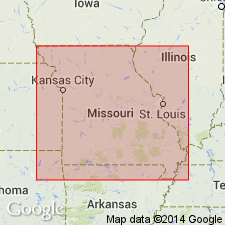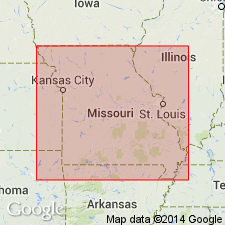
- Usage in publication:
-
- Bachelor formation
- Modifications:
-
- Original reference
- Dominant lithology:
-
- Sandstone
- AAPG geologic province:
-
- Ozark uplift
Summary:
Pg. 94-98. Bachelor formation. Proposed for a basal Mississippian sandstone that cuts across time zones ranging in age from oldest Mississippian to as late as early Osagean. With exception of Siphonodella zone at base, lithology is varied although it consists dominantly of pale buff quartz sandstone of medium grain size, moderately well to poorly sorted. Over most of extent, including Siphonodella zone, thickness of unit is to be measured in inches rather than feet. In Callavvay County, average thickness is perhaps less than 2 feet; in east-central Callaway and western Montgomery Counties, thicknesses of as much as 8 to 10 feet may be found. Unconformable above underlying strata; subjacent beds range from Jefferson City Ordovician to late Massie Creek (new); conformable with overlying strata of Burlington or Chouteau.
Exposure in streambed, in SE/4 NW/4 SW/4 sec. 9, T. 48 N., R. 8 W., Callaway Co., MO. Named from exposures to east, west, and south of Bachelor.
Source: US geologic names lexicon (USGS Bull. 1200, p. 187-188).

- Usage in publication:
-
- Bachelor Formation
- Modifications:
-
- Overview
Summary:
Pg. 19. Bachelor Formation not included in Chouteau Group. Has been correlated with the Sylamore Sandstone of Arkansas (a facies of the Upper Devonian Chattanooga Shale) and with the Lower Mississippian Bushberg Sandstone of eastern Missouri. Overlies strata from as old as Ibexian (Early Ordovician) to Late Devonian, and is overlain by Kinderhookian carbonates (Compton Limestone to "Chouteau limestone undifferentiated") except for east-central Missouri where it is directly overlain by the Osagean Fern Glen Formation. Age is Kinderhookian.
Source: Publication.
For more information, please contact Nancy Stamm, Geologic Names Committee Secretary.
Asterisk (*) indicates published by U.S. Geological Survey authors.
"No current usage" (†) implies that a name has been abandoned or has fallen into disuse. Former usage and, if known, replacement name given in parentheses ( ).
Slash (/) indicates name conflicts with nomenclatural guidelines (CSN, 1933; ACSN, 1961, 1970; NACSN, 1983, 2005, 2021). May be explained within brackets ([ ]).

